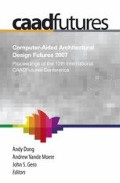The research presented in this paper addresses the issue of bridging conceptual differences between the theories and practice of various disciplines in the AEC industry. The authors propose an application logic that works as a framework in assisting the evaluation process of multidisciplinary design. Parametric design templates assist in channeling and integrating information generated during the design process.
Access this chapter
Tax calculation will be finalised at checkout
Purchases are for personal use only
Preview
Unable to display preview. Download preview PDF.
References
Acha, VI, Gann, DA, and Salter, AM: 2005, Episodic innovation: R&D strategies for project-based environments, Industry and Innovation 12(2): 255-281.
Aish, RO: 2005 From Intuition to Precision, Digital Design: The Quest for New Paradigms, 23rd eCAADe Conference Proceedings, Lisbon, Portugal, pp. 10-14.
Baldock RO: 2004 Structural System Optimisation Techniques for the Building Industry, Cambridge University Engineering Department Report.
Bedrick, JI and Rinella, TO: 2006, Technology, process, improvement, and culture change, AIA Report on integrated practice. Retrieved January 11, 2007 from http://www.aia.org/ SiteObjects/files/8_Bedrick%20Rinella.pdf.
Chaszar, AN: 2003, Bridging the Gap with Collaborative Design Programs, Architectural Design 73(5): 112-18.
Eastman, CH: 1999, Building Product Models: Computer Environments Supporting Design and Construction, CRC Press, Boca Raton, Florida.
Eastman, CH: 2006 University and industry research in support of BIM, AIA Report on integrated practice. Retrieved November 12, 2006 from http://www.aia.org/SiteObjects/ files/2_Eastman.pdf.
Kannengiesser, UD and Gero, JO: 2004 Using Agents in the Exchange of Product Data, in:M Bramer and V Devedzic (eds), Artificial Intelligence Applications and Innovations, Kluwer, Dordrecht, pp. 129-140.
Malkawi, AM: 2004, Performance Simulation: Research and Tools, in: B Kolarevic and AM Malkawi (eds), Performative Architecture: Beyond Instrumentality, Spon Press, New York, pp. 85-94.
Mueller, VO: 2006, Integrating Digital and Non-digital Design Work, Blurring the Lines: Computer-Aided Design and Manufacturing in Contemporary Architecture, Academy Press, pp. 38-46.
Onuma, KI:2006, The twenty-first century practitioner: Transformed by process not software, AIA Report on integrated practice. Retrieved December4,2006 from http://www.aia.org/SiteObjects/files/6_Onuma.pdf.
Pratt, MI and Kim, JU: 2006, Experience in the exchange of procedural shape models using ISO 10303 (STEP) Proceedings of the 2006 ACM symposium on Solid and physical modeling, Cardiff, pp. 229-238.
Shelden, DE: 2006, Tectonics, Economics and the Reconfiguration of Practice: The Case for Process Change by Digital Means, in: M Silver (ed), Programming Cultures, Architecture, Art and Science in the Age of Software Development , John Wiley & Sons, London, pp. 82-88.
Silver, MI: 2006, Towards a Programming Culture in Design Arts, in: M Silver (ed), Programming Cultures, Architecture, Art and Science in the Age of Software Development, John Wiley & Sons, London, pp. 5-11.
Sprecher, AA, Chandler AH and Neumann, ER: 2006, Critical Practice: Protocol for a Fused Technology, in: C Hight and C Perry (eds), Collective Intelligence in Design, John Wiley & Sons, London pp. 31-35.
Taylor, JO and Levitt, RA: 2004, Understanding and Managing Systemic Innovation in Project-based Industries, in: DP Slevin, DI Cleland and JK Pinto (eds), Innovations: Project management research, Project Management Institute, Newtown Square, Pennsylvania, pp. 83-99.
Wan, C, Chen, P and Tiong, R: 2004, Assessment of IFC’s for Structural analysis domain, Electronic Journal of Information Technology in Construction. Retrieved March 2, 2007 from http://www.itcon.org/cgi-bin/works/Show?2004_5.
Author information
Authors and Affiliations
Editor information
Editors and Affiliations
Rights and permissions
Copyright information
© 2007 Springer
About this paper
Cite this paper
Holzer, D., Tengono, Y., Downing, S. (2007). Developing a Framework for Linking Design Intelligence from Multiple Professions in the AEC Industry. In: Dong, A., Moere, A.V., Gero, J.S. (eds) Computer-Aided Architectural Design Futures (CAADFutures) 2007. Springer, Dordrecht. https://doi.org/10.1007/978-1-4020-6528-6_23
Download citation
DOI: https://doi.org/10.1007/978-1-4020-6528-6_23
Publisher Name: Springer, Dordrecht
Print ISBN: 978-1-4020-6527-9
Online ISBN: 978-1-4020-6528-6
eBook Packages: Architecture and DesignEngineering (R0)

